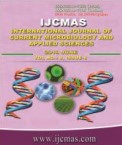


 National Academy of Agricultural Sciences (NAAS)
National Academy of Agricultural Sciences (NAAS)

|
PRINT ISSN : 2319-7692
Online ISSN : 2319-7706 Issues : 12 per year Publisher : Excellent Publishers Email : editorijcmas@gmail.com / submit@ijcmas.com Editor-in-chief: Dr.M.Prakash Index Copernicus ICV 2018: 95.39 NAAS RATING 2020: 5.38 |
The presence of Escherichia coli (EC) microorganisms in live organs can cause foodborne illnesses and food-related deaths. Here, EC assay was performed using a microcopper three-electrode (MCE) system, where a handmade MCE was used as a working electrode and Ag/AgCl as reference and platinum counter electrodes. Under a 1.0-ml EC standard, the diagnostic optimum conditions were sought. The analytical oxidation potential was obtained at -0.2 V via positive scan. Under these conditions, the stripping linear working range was attained with 0.2-0.7 mg/mL EC variations. A statistic relative standard deviation of 6.78% (n=13) was obtained by 1.0 mg/mL EC using 0.0 sec accumulation time. Under optimum conditions, the detection limit was 0.6 mg/mL. Here, the diagnostics were explored real-time in the blood vascular system of a live frog. Moreover, which probe can be used for in-vivo clinical application in animal organs (heart, colon, lungs, and gallbladder) was determined as the patient’s peak current increased a hundred times more than in the negative tissue. The sensing time was only 30 sec. This method is simpler than the common PCR amplification, electrophoresis, and photometric detection methods and can be useable for fluorescence analytical catheter probe.
 |
 |
 |
 |
 |